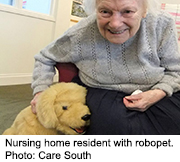FRIDAY, May 10, 2019 (HealthDay News) — Cuddler the bear, Aibo the dog, Justocat the purring kitty: They may only be furry, lifelike robots, but they have a made a real impact in nursing homes.
That’s the finding of new British research that suggests these high-tech “robopets” are the next best thing for nursing home residents unable to have a beloved pet or those suffering from loneliness.
“Although not every … resident may choose to interact with robopets, for those who do, they appear to offer many benefits,” study author Rebecca Abbott, of the University of Exeter Medical School, said in a university news release.
The robopets stimulate conversations and trigger fond memories of pets or past experiences, Abbott said. “And there is also the comfort of touching or interacting with the robopet itself. The joy of having something to care for was a strong finding across many of the studies.”
One U.S. geriatrician who was not involved in the study said engagement with a robotpet does seem helpful.
“Most importantly, it was found to decrease loneliness and increase pleasure and joy, and bring comfort,” said Dr. Maria Torroella Carney. She directs geriatrics and palliative medicine at Northwell Health in Great Neck, N.Y.
In the new study, Abbott’s group analyzed data from 19 studies involving 900 nursing home residents, family members and staff at centers worldwide. Five different robopets were used in the studies: Necoro and Justocat (cats); Aibo (a dog); Cuddler (a bear); and Paro (a baby seal).
Many nursing home residents were entertained by the robopet even if they realized it wasn’t a real dog or cat. Of course, “residents’ responses could vary according to whether they were living with dementia and according to the severity of the dementia,” Abbott’s team noted.
Some residents talked to the robopet as if it were, in fact, alive and a real animal. Some even made an emotional connection with the “pet.” For example, one resident told staff, “I woke up today and thought, today is going to be a good day because I get to see my friend.”
For others, just holding and stroking the robopet brought “them back into a space in their life where they feel loved,” as one nursing home caretaker put it in the study.
As to whether the robopet felt “real,” one resident’s family member said that it “doesn’t matter, because I can see that the robotic cat has an impact on my dad’s quality of life.”
Besides their other benefits, robopets appeared to boost social interaction with other residents, family members and staff, often by acting as a trigger for conversation, according to the research.
Of course, not every nursing home resident was enthused about the robopet. Some ignored them or even reacted negatively, and others were put off by their artificiality.
That means that specific staff training about the best use of the devices should help residents get the most out of the technology, Abbott and colleagues suggested.
For example, knowing if a person likes animals or once had pets is likely to affect how much they engage with a robopet, the team said.
The bottom line is that “it is not always possible to have a cat or a dog come into a care home, so robopets can offer a good alternative,” study co-author Noreen Orr concluded.
“Of course, robopets are no substitute for human interaction,” she said, “but our research shows that for those who choose to engage with them, they can have a range of benefits.”
For her part, Carney said questions remain around the benefits of the technology.
For example, while the emotional benefits for some residents seem clear, “we don’t know if this [technology] decreases medication use or any other health outcomes,” she said. Also, more study is needed into “which population of patients have best engagement and benefit,” Carney said.
And there’s one other drawback, for now: Robopets can be prohibitively expensive. However, “a new wave of more affordable robopets may make them more accessible to care homes,” Orr believes.
The study, which received no private industry funding, was published May 9 in the International Journal of Older People Nursing.
More information
HealthinAging.org offers tips on choosing a nursing home.
Copyright © 2025 HealthDay. All rights reserved.

